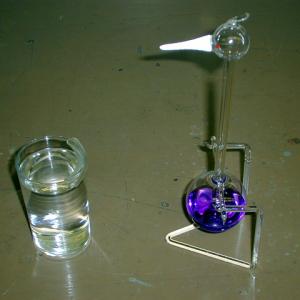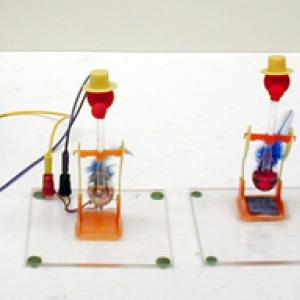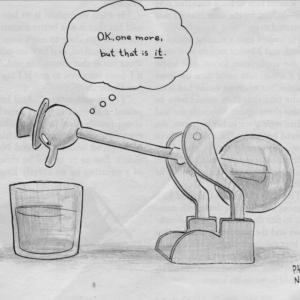College of Liberal Arts & Sciences
4C31.30 - Drinking Bird - Relaxation Oscillators
Video Credit: Jonathan M. Sullivan-Wood.
Wet the head part of the drinking bird. The evaporation of the water from the head will cause the liquid to rise to the top for about 1 hour without additional wetting.
NOTE: Take care that the large drinking bird does not fall off the glass stand. This is particularly important if the bird is not on a level area.
The drinking is also an example of a relaxation oscillator.
We have a variety of relaxation oscillators available. Look at these webpages:
3A95.10 - Relaxation Oscillators
6-00.00 - Stroboscope (we have small variable frequency strobe lights available).
2B60.30 - Tantalus Cups
3D32.15 - Stadium Horn
4C30.25 - Geyser
4C31.30 - Drinking Bird
4C31.37 - Franklin's Pulse Glass Engine
5A40.70 - Kelvin Water Dropper
5F30.60 - Relaxation Oscillators - Neon Bulb, Doorbell, and Strobe Lights
10A06.10 - Relaxation Oscillators
13A10.10 - Perpetual Motion
- K. P. Trout, Charles A. Gaston, "An Unexpected Heat Engine", TPT, Vol. 50, #1, Jan. 2012, p. 32.
- J. Guemez, R. Valiente, C. Fiohais, and M. Fiolhais, "A Big Sunbird", TPT, Vol. 42, #5, May 2004, p. 307.
- Stuart E. Leinoff, "Keeping a Cool Head", TPT, Vol. 31, #5, May 1993, p. 263.
- Robert Mentzer, "The Drinking Bird - The Little Heat Engine That Could", TPT, Vol. 31, #2, Feb. 1993, p. 126.
- Richard Crane, "What Does the Drinking Bird Know About Jet Lag?", TPT, Vol. 27, #6, Sept. 1989, p. 470.
- James Vokac and William Blunk, "Bubble Lights", TPT, Vol. 23, #9, Dec. 1985, p. 566.
- "Drinking Duck Shutter", TPT, Vol. 5, #7, Oct. 1967, p. 342, also A Potpourri of Physics Teaching Ideas - Odds and Ends, p. 304.
- Kemp Bennett Kolb, "Reciprocating" Engine", TPT, Vol. 4, # 3, Mar. 1966, p. 121.
- Ralph Lorenz, "Finite-Time Thermodynamics of an Instrumented Drinking Bird Toy", AJP, Vol. 74, #8, Aug. 2006, p. 677.
- Nadine Abraham and Peter Palffy-Muhoray, "A Drinking Bird of the Second Kind", AJP, Vol. 72, # 6, June 2004, p. 782.
- J. Guemez, R. Valiente, C. Fiolhais, and M. Fiolhais, "Experiments with a Sunbird", AJP, Vol. 71, #12, Dec. 2003, p. 1264.
- J. Guemez, R. Valiente, C. Fiolhais, and M. Fiolhais, "Experiments with a Drinking Bird", AJP, Vol. 71, #12, Dec. 2003, p. 1257.
- Carl Bachhuber, "Energy from the Evaporation of Water", AJP, Vol. 51, #3, Mar. 1983, p. 259.
- Hj-7: "Drinking Bird", Freier & Anderson, A Demonstration Handbook for Physics.
- H-240: "Drinking Bird", DICK and RAE Physics Demo Notebook.
- Jodi and Roy McCullough, "Thermodynamics with a Drinking Bird", The Role of Toys in Teaching Physics, p. 4.29.
- Borislaw Bilash II, David Maiullo, "A Bird That Drinks Many Ways", A Demo a Day: A Year of Physics Demonstrations, p. 231.
- Jearl Walker, "4.63, Large Dunking Birds", The Flying Circus of Physics Ed. 2, p. 204.
- Jearl Walker, "4.62, Dunking Bird", The Flying Circus of Physics Ed. 2, p. 203.
- Ed Sobey, Woody Sobey, "Dunking Bird", The Way Toys Work, p. 37.
- Tik L. Liem, "The Drinking Bird", Invitations to Science Inquiry - Supplement to 1st and 2nd Ed. p. 54.
Disclaimer: These demonstrations are provided only for illustrative use by persons affiliated with The University of Iowa and only under the direction of a trained instructor or physicist. The University of Iowa is not responsible for demonstrations performed by those using their own equipment or who choose to use this reference material for their own purpose. The demonstrations included here are within the public domain and can be found in materials contained in libraries, bookstores, and through electronic sources. Performing all or any portion of any of these demonstrations, with or without revisions not depicted here entails inherent risks. These risks include, without limitation, bodily injury (and possibly death), including risks to health that may be temporary or permanent and that may exacerbate a pre-existing medical condition; and property loss or damage. Anyone performing any part of these demonstrations, even with revisions, knowingly and voluntarily assumes all risks associated with them.


